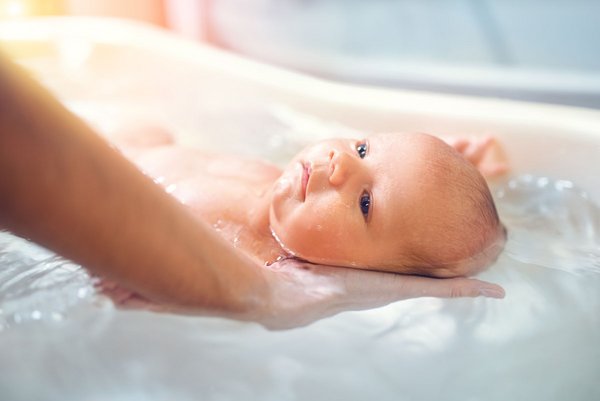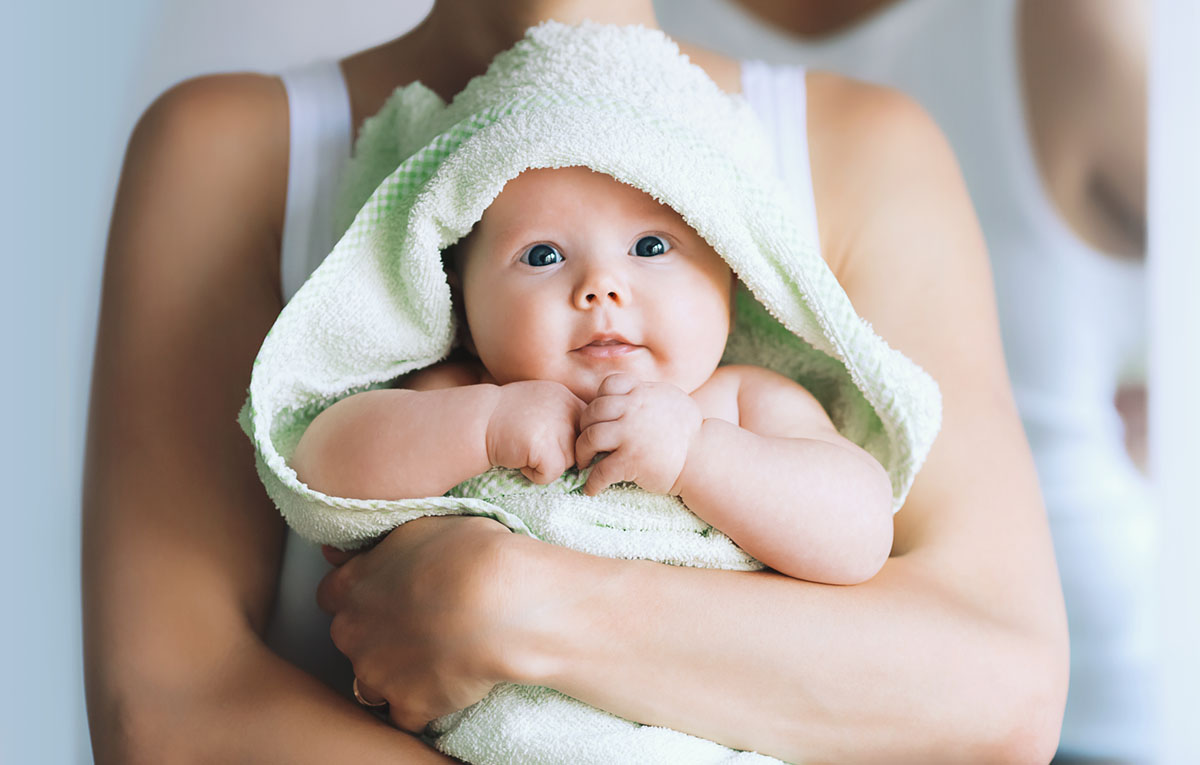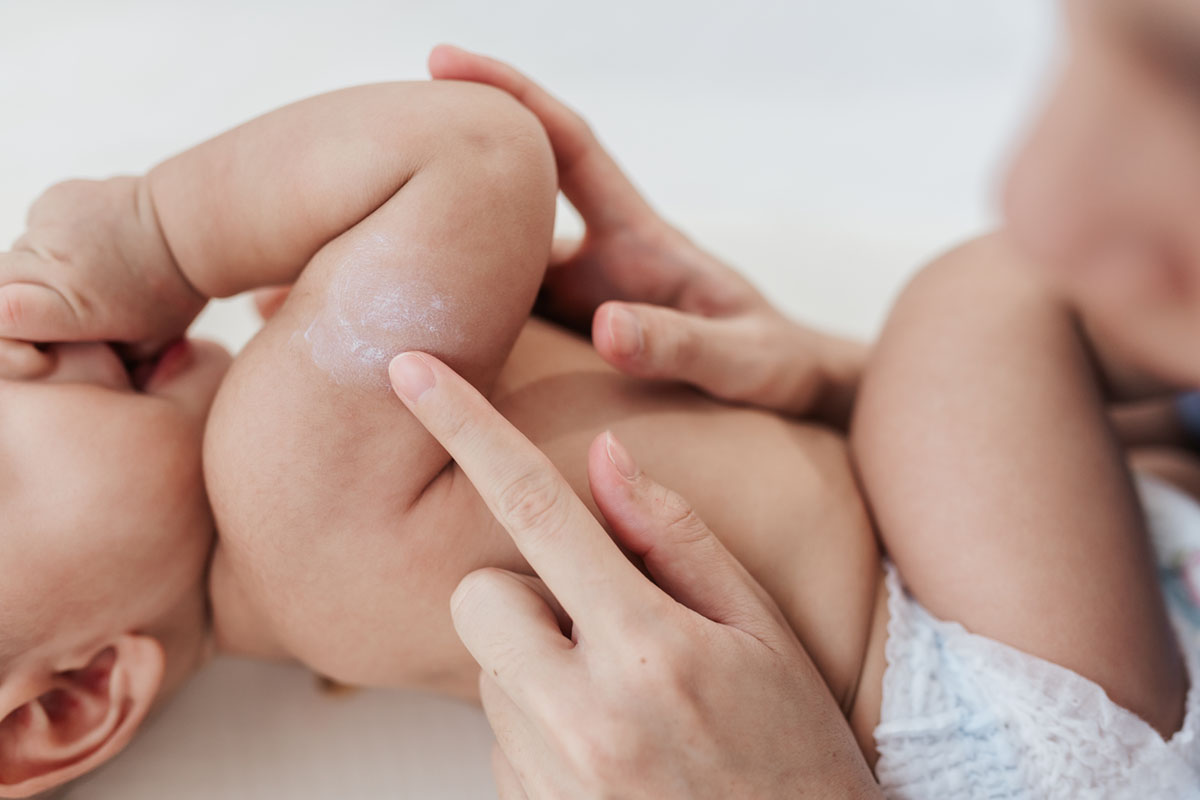Bathing of Newborn
Tips for the First Baby Bath
For first-time parents, bathing their newborn is an exciting event for everyone involved. Many parents worry about doing something wrong. Typical questions arise, such as: How warm should a baby's bath be? Does the water need any additives? When can you start bathing babies? And how often should babies be bathed?
Bathing a baby might sound complicated, but it really isn't. There are a few basic rules. If you follow them, you can't really go wrong!
Baby care for skin and hair
Linola Baby & Kind
The First Time in the Tub
When should you bathe your baby?

You're considering bathing your baby for the first time. But when is your little one actually ready for it? You should wait with the first bath until the umbilical cord has fallen off and the navel is completely healed. This prevents germs from entering the wound, which could potentially cause an infection. Until then, it's best to gently wash your newborn with a lukewarm washcloth.
Bathing a Newborn – The Preparation
The time has come – your baby's first bath is imminent. First and foremost: The regular bathtub is off-limits! Instead, use a baby bath or a bath bucket. Gather all the necessary items in advance so that you never have to leave your baby unattended.
What you'll need are one to two soft washcloths and, if possible, a pre-warmed, soft towel for drying. If your infant already has hair on their head, also have the baby brush at hand.
Checklist: What do I need to bathe my baby?
- Baby bath/bath bucket
- 1-2 soft washcloths
- Pre-warmed, soft towel
- Possibly a baby brush
When can an additive be used for baby baths?

Your baby doesn't necessarily need a bath additive in the first few weeks. As a guideline for when it's appropriate to add a care product to the water, consider the ninth week. Then, if needed, you can use a moisturising bath additive, provided your child isn't allergic to it, or a product specifically developed for babies that keeps your little one's skin silky soft.
Even a dash of breast milk, thanks to its high fat content, can serve as a care product. What you bathe your baby with should depend on what benefits the little cherub. The best way to find out which bath additive your baby likes is through a practical test.
Water Temperature & More
Tips for Baby Bathing
Location:
The room where the bath takes place should be comfortably warm. The same goes for the bathwater: For your little one, a water temperature of 37-38° Celsius is ideal. This ensures they neither get too cold nor scalded. Fill the bath so that your baby's shoulders are covered. Remember to clean your baby's bottom beforehand if needed, to prevent any germs from entering the bathwater!
Timing:
If you're wondering when is the best time to bathe your baby: Choose a time when you can fully dedicate yourself to the task. It should become a lovely ritual for both you and your baby, and should never become stressful. Ensure your baby is in a good mood. They should neither be hungry nor freshly fed.
Bathing Technique
Holding and Washing the Baby Correctly
Place one arm under your child's head and upper back, gently grasping their shoulder with your hand. The other hand supports the bottom as you lower them into the water. Afterwards, use this hand for washing.
Start by gently cleaning your baby's face and neck, then work your way downwards. Pay attention to skin folds and hard-to-reach areas, such as behind the little ears. Finally, wash your child's nappy area.
Very importantly: Never take your eyes off your baby while they're in the water!
After the Bath: Towel Dry or Blow Dry?
Why the Towel Has Advantages

If the bathroom is comfortably warm, it's recommended to dry the baby with a soft towel and the loving hands of the parents. The reasons are numerous:
- Physical touch from the parents' hands offers the baby more security and comfort than an inconsistent draft.
- A hairdryer can emit very hot air, increasing the risk of burns.
- Especially older hairdryers can blow dust particles into the air, which can be counterproductive for the healing process if the baby has open areas or a sore bottom.
Therefore, it's advisable to skip the hairdryer and instead prefer traditional towel drying.
Always thoroughly dry your freshly washed treasure. Moisture, for example in skin folds, can quickly lead to sore skin in babies. Be gentle in your approach. Avoid rough rubbing and instead pat gently.
Some infants are prone to dry skin or suffer from what's called nappy rash, which means sore areas in the nappy region. In both cases, it's beneficial to moisturise your baby after the bath. Only use skin care products that are tailored to the sensitive skin of babies.
Take this opportunity for a baby massage as well. It's not only good for your little one but can also positively influence the bond between the two of you.
Frequency of Baby Bathing
How often should babies bathe?
How often you should bathe your baby depends on the child's age. It's best to bathe an infant once or twice a week, but definitely no more than that. Babies don't sweat and generally don't get dirty. Moreover, their skin is very sensitive, so excessive care can be harmful to the baby.

"Babies can be bathed once or twice a week. Even after a vaccination, there's nothing against bathing as long as the baby is feeling well and doesn't have a fever. Newborns can have their first bath once the umbilical cord stump has fallen off and the navel has healed."
Edith Janzen, Midwife at the Birthing Centre Bielefeld, Germany
The general rule is: Observe your child! If you notice that your baby feels uncomfortable during the bath, give them a bit more time and clean them with just a washcloth for a few more occasions.
Linola Baby & Kind
For baby-soft skin
Content verified by

Content verified by: Edith Janzen
Edith Janzen has been a midwife at the Birthing Centre Bielefeld in Germany since 2012 and is a mother herself. Her areas of expertise include out-of-hospital obstetrics, prenatal care, and postnatal care. She supports numerous families from the beginning of pregnancy through childbirth to the end of the postpartum period, providing advice and assistance during this special phase of life.
Additional topics & information
All about child and baby care

Moisturising Your Baby – What Matters in Baby Skin Care
To moisturise your baby or not? This question can't be answered broadly. What's certain is that baby skin is much thinner than that of adults and therefore needs special protection. Here, you'll find tips on what to consider for baby care.

Dry Skin in Babies – Causes and Skin Care Tips
Dry baby skin is more common than you might think and is harmless in most cases. However, the dry areas can cause itching, potentially affecting the baby's comfort.

Nappy Rash in Babies – What to do about a sore baby bottom?
Despite gentle changing, it has happened: the baby's bottom has become sore. A nappy rash is very common in babies. With the right care and additional measures, you can not only provide relief for your little one but also effectively prevent it.




